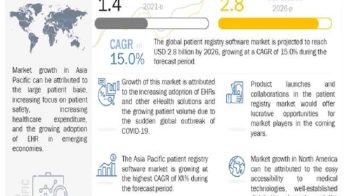The Asia-Pacific region presents huge opportunities for growth in the ambulatory EHR market owing to the investments and reforms to modernize China’s healthcare infrastructure, the digital healthcare scenario in India, Japan’s favorable outlook for HCIT, and the implementation of e-Health in Australia. The global ambulatory EHR market is projected to grow from USD 3.92 billion in 2016 to USD 5.20 billion by 2021, at a CAGR of 5.8% during the forecast period.
The report provides an overall understanding of the market. The application segment includes practice management, patient management, e-prescribing, referral management, population health management, decision support, and health analytics. In 2016, the practice management segment commanded the largest share of the global ambulatory EHR market. These solutions increase the efficiency of day-to-day operations, enhance the value of services provided, and ensure compliance with regulatory requirements.
The delivery mode segment of the market includes cloud-based solutions and on-premise solutions. The cloud-based solutions segment commanded the largest share of the global ambulatory EHR market in 2016 and is expected to be the fastest growing segment during the forecast period. The market is mainly driven by the advantages associated with cloud-based solutions, which include flexibility and cost reduction in healthcare delivery.
On the basis of practice size, the global ambulatory EHR market is categorized into large practices, small-to-medium-sized practices, and solo practices. The large practices segment commanded the largest share of the global ambulatory EHR market in 2016, owing to factors such as the availability of capital investments, ability to handle the productivity challenges that are created by new EHR adoption, and ability to choose among vendors. However, the small-to-medium-sized practices segment is estimated to register the highest growth rate primarily due to the funding provided by regional exchange centers (REC) to support the adoption of EHR among these users.
The end user segment of the ambulatory EHR market includes hospital-owned ambulatory centers and independent centers. The hospital-owned ambulatory centers segment commanded the largest share of the global ambulatory EHR market in 2016 and is expected to be the fastest growing segment during the forecast period. The large share and high growth rate of hospital-owned ambulatory centers can be attributed to the growing need to improve the profitability of healthcare operations and ensure cost-containment by preventing unnecessary healthcare spending, along with government initiatives to improve the quality of care and payment deduction for eligible professionals who are not meaningful users of Certified EHR.
North America accounted for the largest share of the market in 2016. The large share of the North American ambulatory EHR market can be attributed to factors such as federal mandates, increasing geriatric population, collaboration between stakeholders, the need to curtail healthcare costs, payment deductions driving the adoption of EHR, conferences and workshops to raise awareness in the U.S., growing efforts to enhance healthcare delivery, and the adoption of digital recordkeeping in Canada.

